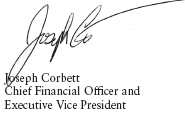 This is my first annual report on the Postal Service’s finances. This year, I proudly became part of a leadership team committed to maintaining the ability of this great organization to affordably serve the needs of American families and businesses. With focused steps to reduce costs and increase efficiency, and through the dedication of our employees who provide excellent service to our customers, we achieved remarkable results that reflect our determination to deliver on our mission in the face of unprecedented financial challenges.
This is my first annual report on the Postal Service’s finances. This year, I proudly became part of a leadership team committed to maintaining the ability of this great organization to affordably serve the needs of American families and businesses. With focused steps to reduce costs and increase efficiency, and through the dedication of our employees who provide excellent service to our customers, we achieved remarkable results that reflect our determination to deliver on our mission in the face of unprecedented financial challenges.
As fiscal year 2009 began, the severe economic issues facing the nation — and countries around the globe — were evident. The Postal Service anticipated continuing declines in mail volumes and revenue. Management set goals to cut spending by a record $4 billion, maintain high levels of service and customer satisfaction, and implement a growth strategy designed to help the Postal Service weather the economic downturn while laying a foundation for future success.
No one could predict how far the economy would contract. As the year progressed, we adjusted our operations and spending in response to the rapidly changing marketplace. The national economy became mired in a deep recession. Substantially all economic activity declined; Gross Domestic Product declined by nearly 3 percent, domestic capital investments declined by more than 22 percent and U.S. retail activity declined by almost 9 percent during FY 2009, according to the economic analysis firm Global Insight. As consumers and businesses cut back on their spending and electronic diversion continued, mail volume continued to decline dramatically with an unprecedented annual loss of over 25 billion pieces of mail or almost 13 percent.
We sharpened our focus to respond and our cost-cutting strategies were remarkably successful. By year’s end, excluding contractual cost increases, we had reduced more than $6 billion in costs across the organization, including work-hour reductions of 115 million hours. This reduction is equivalent to 65,000 full-time employees — larger than the total workforce of more than 80 percent of Fortune 500 companies. That’s an impressive achievement — in any economy. At the same time, our revenue-generation initiatives, including pricing incentives for large-volume mailers, seasonal sales, widespread promotion of our flat-rate shipping options and a reorganized sales force, also showed positive results.
Despite our extraordinary efforts, the Postal Service finished the year with a $6.8 billion revenue decrease. The volume decline of more than 25 billion pieces was the largest in our history. While the volume of mail we deliver to each home is declining, our delivery network continues to grow by approximately a million addresses each year. This growth substantially increases delivery costs.
We will continue initiatives to grow revenues and become even more efficient in 2010. The cost pressures of declining revenue from shrinking mail volume combined with a growing delivery network highlight the need for changes that will allow the Postal Service to adjust to the changing environment. In fact, the U.S. Government Accountability Office during FY 2009 added the Postal Service to its federal “high-risk” list, urging action by Congress and other key stakeholders to develop a plan to help put the organization on a more sustainable financial path.
Although by law we are required to operate as a commercial entity, fully funded by the revenues we earn, and not by tax subsidies, there are unique obligations placed on the Postal Service and restraints on our ability to operate on a level playing field with other commercial entities. For example, our current debt is more than $10 billion, the direct result of a requirement that we pre-fund retiree health benefits through annual payments of $5.4 billion to $5.8 billion through 2016. Although we are thankful the U.S. Congress reduced that amount by $4 billion for fiscal year 2009, we will again face this sizeable outlay next year. It is time to re-examine this payment schedule — which is far more onerous than that which other commercial entities or government agencies are required to make. We also are seeking better control of our delivery schedule to meet the needs of our customers, and we will continue to work with Congress to achieve longer-term structural changes.
Even with the glimmer of a potential economic recovery ahead, we do not expect mail volumes to rebound to their previous high levels. The Postal Service is projecting continued revenue losses for several years, although we anticipate more moderate declines in volume than occurred during FY 2009. We will continue to be aggressive in removing costs from our system where possible. As we prepare for Sarbanes-Oxley compliance in the year ahead, we are identifying additional opportunities for savings through increased financial controls and streamlined processes.
Although we expect another challenging financial year in FY 2010, our goal is to set our finances on firmer footing, and continue to drive out costs and be as efficient as possible. We’re proud to deliver on our promise to deliver trusted, affordable products and services to the American people. A financially sound Postal Service is good for business — and good for the nation. We’re meeting the challenge.
A financially sound Postal Service is good for business — and good for the nation. We’re meeting the challenge.

